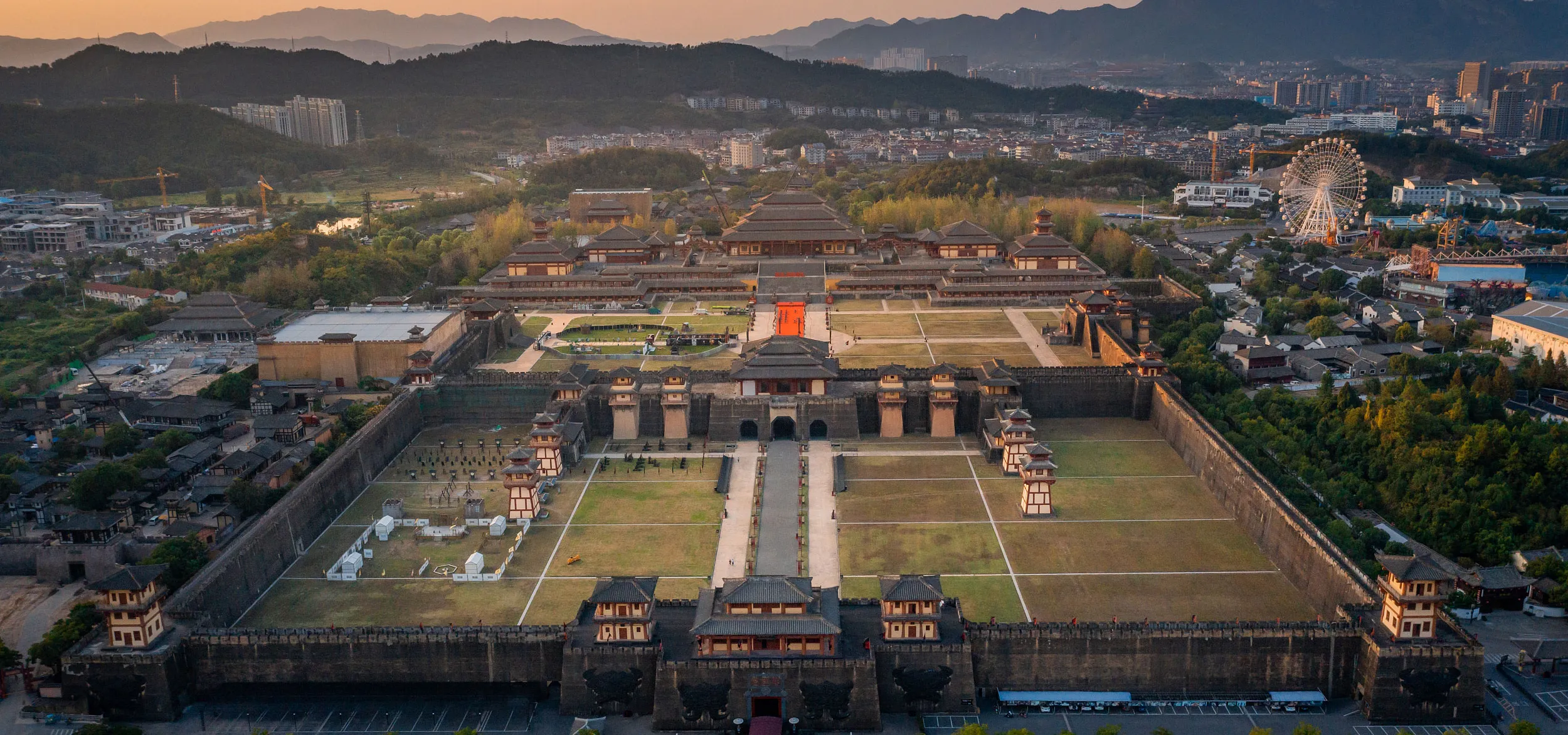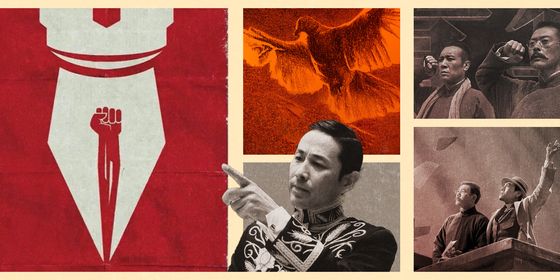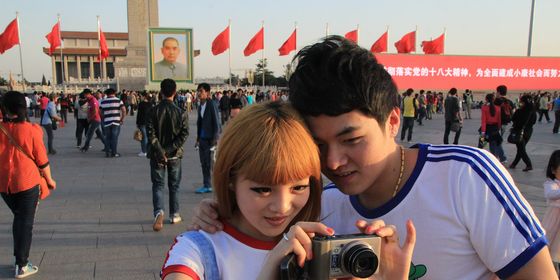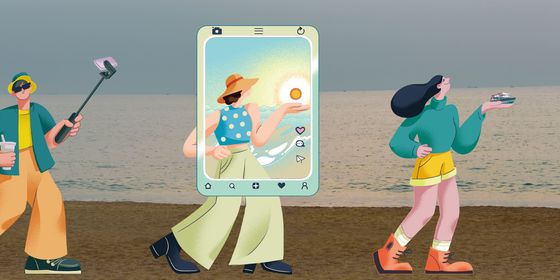More than just a film lot, the vast Hengdian Studios embodies both a history of China and its future
On a sweltering, overcast afternoon, an old bus from Yiwu city is bouncing along the narrow mountain road toward the town of Hengdian, Zhejiang province, its windows covered with translucent dark-blue paper. Inside, it’s gloomy and smells of gasoline. But no one’s complaining: The passengers are looking forward to spotting some celebrities.
“I am sure she is in Guangzhou Street,” says one young woman, discussing actress Zhao Liying (The Journey of Flower, Princess Agents). “We can definitely see her there tomorrow.” Her friend has a different opinion: “The show she is filming is set in the Song dynasty, so they must be in the ‘Riverside Scene at Qingming Festival.’”
We are heading for Hengdian World Studios, the largest outdoor film lot in the world, spanning over 2,500 acres—27 times larger than Paramount and Universal Studios put together. It’s one of China’s biggest attractions, pulling in more than 100 million tourists since it opened in 1996.
Western media sometimes call it “Chinawood,” while Chinese prefer the nickname “Great Heng Kingdom” (大横国). Few in the industry have not paid a visit to its iconic sets, from a gleaming replica of the Forbidden City in Beijing, to the imitation Palace of Emperor Qin in Shaanxi, to reconstructions of the former Northern Song capital of Kaifeng and the streets of colonial Hong Kong and Canton (now Guangzhou).
Together, they supply a historical background of some 2,000 years, from the Qin dynasty to the Republic of China, for potential TV and movie producers. For tourists, a stroll around Hengdian is a journey through time; nowhere else in China can one see so many “historical” sites assembled in a single place.

The famous Fan Restaurant from the Riverside Scene of Qingming Festival (Sun Jiahui)
Others, like my companions on the bus, come with a different aim. According to the South China Morning Post, 20 percent of all Chinese films and TV series are filmed here, and the town has played host to more than 1,800 productions in the past two decades, making Hengdian a pilgrimage spot for those willing to pay hundreds of RMB to glimpse their favorite star. Many actors work in Hengdian for several months a year, perhaps a longer time than they spend at home. Some, like actor Zhang Han (Wolf Warrior 2) or actress Ye Xuan (Drug War, Overheard 3), are reported to have bought houses in town; others even own restaurants here, like Hunan TV favorite Du Haitao and actress Zheng Shuang (Rush to the Dead Summer).
When the bus arrives, though, it’s completely dark, with few people in the street. The two chirping girls get into a car with a middle-aged man who asks if anyone needs a taxi, and disappear into the night.
I look around, only to see a few dim streetlights. Chinawood has no Sunset Strip or Rodeo Drive, no VIP nightclubs or swanky restaurants; barely any nightlife at all, in fact. It’s hard to believe there are superstars somewhere in this low-profile town. But boring as it may be, filmmakers relish Hengdian’s opportunity for one-stop-shop continuous shoots. Taking a breath of autumn air, I reassure myself: “Here it is. Here is the biggest star factory in China.”
Next morning, I start with Guangzhou and Hong Kong Street, because it is here that the Hengdian story began. In 1995, famous director Xie Jin was scouting locations for Opium War, a state-backed movie about China’s humiliating loss to the British in 1842, tightly scheduled to open in theaters nationwide on the date of the Hong Kong handover, but couldn’t find anywhere suitable for shooting 19th-century street scenes. Hearing this, Xu Wenrong, founder of electronics company the Hengdian Group, came to Xie and volunteered to build a site from scratch. It was this outlandish proposal that changed the fate of this small town, located hours from the nearest major city, with no rail or air connection at the time.
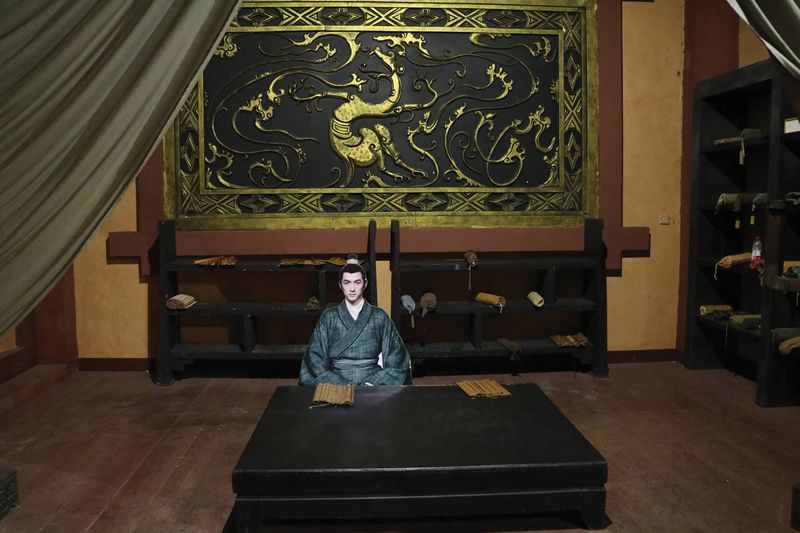
Mei Changsu’s living room in the Palace of Emperor Qin (Sun Jiahui)
Back then, Hengdian was known for its poverty. “When you raise your head, all you see is Bamian Mountain/ Diluted porridge three times a day fends off famine and cold/ If you have a daughter, never marry her to a man from Hengdian,” went one grim local rhyme. In 1975, the 40-year-old Xu defied the prevailing Maoist-collectivist orthodoxy to found a private enterprise, beginning with manufacturing silk reels, then diversifying into electronics components. A move into the entertainment industry—song-and-dance shows in backwater resorts—did not take off, but then Xu met director Xie, a fellow Zhejiang native, in 1995, and found himself with an order for 100 Qing-style houses, a tower, and an imitation Zhujiang River within three months.
It sounded almost impossible, but Xu agreed. According to an autobiography published in 2011, Xu assigned the project to 120 work teams, building round the clock. Since the scenery needed to look old, Xu dispatched men to buy worn stone floor tiles from peasants, and even took unmarked tombstones from graves to meet the deadline.
Today, there are complete replicas of street scenes from the 19th century: European-style two-story mansions, the Hong Kong and Shanghai Bank, an old-fashioned theater and ballrooms a few steps away from Chinese-style restaurants, the imperial examination hall, and obsolete temples (Hengdian does have a working temple, though, with its own abbot; the Dazhi Chan Monastery is based on a sixth-century original and doubles as a set).
The site is smaller than one might imagine, however, and the layout is strange, with the buildings distributed in a way that would be irrational in a real town. That day, some areas are closed for shooting, so I wander awhile outside, hoping to see some stars—perhaps even Zhao Liying. Unfortunately, I only saw an extra in costume walking through an archway, making a phone call.

A shooting site in the Guangzhou and Hong Kong Street (VCG)
Hengdian draws thousands of such people every year; some looking for background work, others hoping for a big break. It’s common to see groups of young migrants hanging around areas like the Street of Great Knowledge, killing time. With the right look—a corpulent businessman, say, or a devilish Japanese invader—a good extra can make over a 100 USD a day, and only work half the year. But many feel the need to stay in town year-round, working assorted gigs with casting directors and photography studios; plenty more give up and drift away from Hengdian, in search of new roles in life.
A tour bus takes just a few minutes to deposit me at the Palace of Emperor Qin, the original of which is supposed to lie in ruins in Shaanxi province. In Hengdian, though, the Qin Emperor’s glories are very much intact, and the gates of China’s first imperial palace are besieged with tourists, rather than barbarians. An actor dressed as a soldier poses patiently for thousands of photos a day. With its grandiose entrance, tall walls, vast grounds and 99 steps, the palace looks as solemn and real as it did in the movie it was built for 20 years ago, The Emperor And The Assassin, directed by Cannes favorite Chen Kaige (Farewell My Concubine).
The 1997 movie had been in the development stage for four years, with blueprints drafted for a palatial set, when Chen came to Xu to help make it a reality. Word had spread in movie circles about Xie’s successful Opium Wars shoot at Hengdian, and Chen had a similar proposition, only bigger. Over the next eight months, mountains were blown up, villages flattened, and a palace covering over 500,000 square meters and made up of 27 halls rose up out of nothing.
Many would argue the damage was worth it: Qin’s palace has served for more than 500 movies and TV series, including Zhang Yimou’s Hero and Curse of the Golden Flower, both known for their grandiose, beautiful scenes. In a narrow passage between two palace walls, dozens of life-sized cardboard cutouts are displayed, all characters from dramas that have been filmed here. Inside the palace, I recognize the living room of Mei Changsu, the hero from hit show Nirvana in Fire, played popular actor Hu Ge; Mei’s cardboard cut-out is sitting behind a table near the fireplace, just as he usually did in the show. Only a signboard inscribed with the title hanging above its door, and tourists taking photos with “Mei,” broke the illusion.
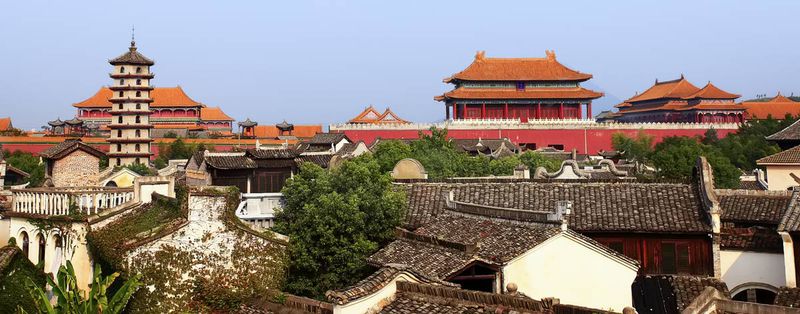
At Hengdian, folk dwellings are built cheek-by-jowl with the Forbidden City (VCG)
Usually, most stories set before the Tang dynasty can be filmed in the Palace of Emperor Qin. But when it comes to the next dynasty, the Song, the studio has another site specially for it—Riverside Scene at Qingming Festival, named after the famous painting of the same name by Song artist Zhang Zeduan. Considered the most renowned work among all Chinese paintings, it depicts in detail the street scenes and people’s daily life in Bianliang, currently Kaifeng, Henan province. Here in Hengdian, everything from the iconic painting has become three-dimensional: Song-style houses, stone paths, small bridges, glassy water, gaily painted boats, and pavilions situated in the center of the lake.
The difference is that, unlike the Qin palace, everything here looks artificial and miniature. A house with a plaque over the gate is just called “The Mansion of the Prime Minister;” a wooden gate and a small raising flag makes up the “The Marshes of Mount Liang” (where, in Outlaws of the Marsh, the heroes assemble to rebel against the government); and the signboard outside a small yard proclaims itself the Muke Fastness (a well-known place in the folklore “Generals of the Yang Family”).
Having seen how simple and crude these sets are, the importance of cinematography, photography, and post-production becomes immediately evident. Indeed, many of these lots may themselves become largely redundant in future, as technology and special effects take an increasingly important role in filmmaking: To this end, Hengdian has invested millions in digital post-production, with Hengdian Film Production offering services like CGI and touching up that may, one day, mean the sets themselves become mere theme park attractions.
But with so much of Hengdian’s work coming from multitudes of low-budget, cookie-cutter productions, that day is still some way off. And many of the sets are stunning: The best part of Riverside Scene at Qingming Festival is the Fan Restaurant, a replica of the popular Song diner. According to the original structure described in Reminiscences of the Eastern Capital (《东京梦华录》), the Fan Restaurant has three floors and five branch buildings all decorated with multiple lanterns. The path in front of its gate stretches to the bridge over the river. When I arrived there is still a big plaque on the building that reads “Beauty Private Kitchens,” the name of a TV drama aired months ago.
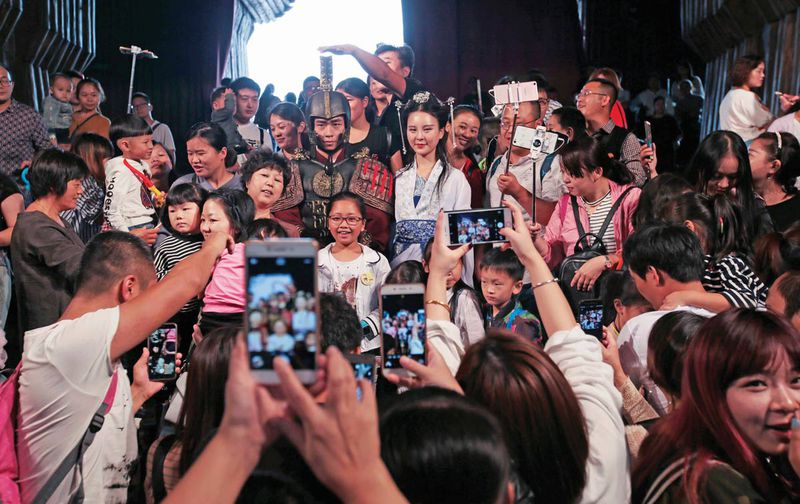
Tourists take photos with staff in costume at the gate of the Palace of Emperor Qin (VCG)
The last stop of my tour is the Palace of the Ming and Qing Dynasties, the largest scenic area of the studio, and more popularly known to foreigners as the Forbidden City. It was built in 1998 to a 1:1 ratio, with only the Tian’anmen Rostrum shrunk by 20 percent. The total area is about one million square meters, twice the size of the Palace of Emperor Qin. In order to build it, 13 small hills were blown up. There are four major structure series: palaces, royal gardens, residence of princes and government offices, and hutong and folk dwellings, each giving a faithful representation of their original Old Peking appearance.
In the Palace of Emperor Qin, there are always blood-curling stories told about the fate of heroes and emperors, but stories shot in the Forbidden City—despite the real palace’s equally gory and tragic history—are more prone to focus on romance, often the duplicitous and tangled love lives of imperial concubines. Since series of this genre are extremely popular in recent years, this area has become increasingly appealing for TV audiences to visit.
When I arrive, the major buildings like the Qianqing Palace and Kunning Palace had not attracted many tourists. Instead, most had gathered beside an ordinary-looking red wall, taking photos and discussing it with each other. Going closer, I overhear someone say: “Here is where Zhen Huan was slapped by Concubine Qi!”—that’s a plot point in the hit show Empresses in the Palace. Later, as I pass by a cloister, another group of girls nearby are pointing at the steps and asking: “Isn’t that where Ruoxi and Mingyu had a fight?” Both characters are from the time-traveling romance series Treading On Thin Ice; such shows started to become hugely popular in 2011, though censors technically forbid programs that “casually make up myths, have monstrous and weird plots, use absurd tactics, and even promote feudalism, superstition, fatalism, and reincarnation.”
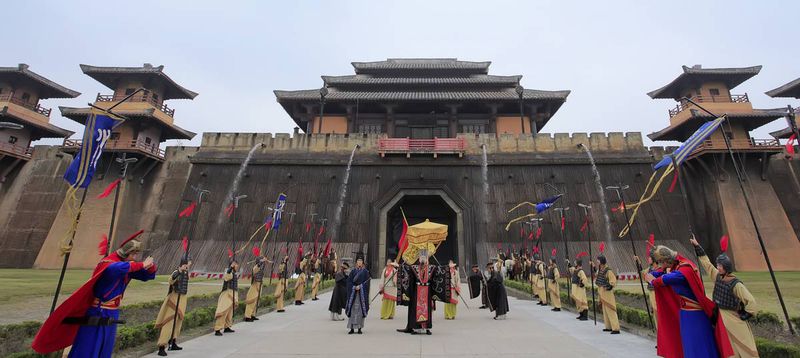
Actors shooting a dramatic scene in the Palace of Emperor Qin (VCG)
Looking at their excited expressions, I suddenly understand what Hengdian meant for them. It doesn’t matter whether the buildings are authentic or fake, the layouts reasonable or haphzard. No one ever expects the real Forbidden City. For them, visiting Hengdian is more like a ritual, to stand on their own feet in this dreamland where their favorite movies are born, to take a breath of the same air that their beloved characters had inhaled.
When I leave, it’s getting late. Tourists are walking back toward the gate, leaving the lots bathed in the warm twilight, silent and empty. When I take another bus back to Yiwu, the passengers around me seem to be tired and sleepy. There’s no talk or gossip. The two girls I met on my way to Hengdian come to my mind. I wonder, did they find Zhao Liying, or not?
Dream Factory is a story from our issue, “Cloud Country.” To read the entire issue, become a subscriber and receive the full magazine.





